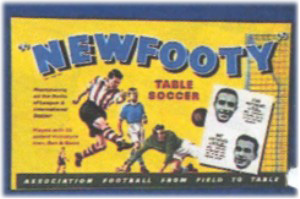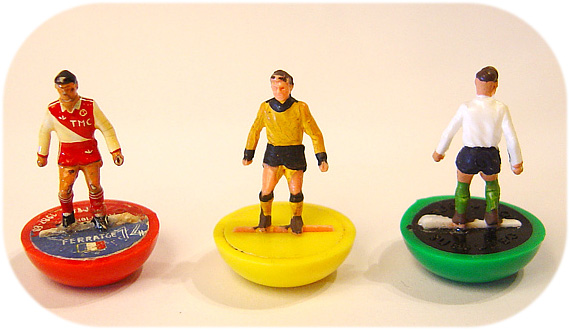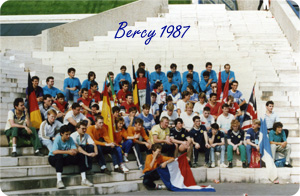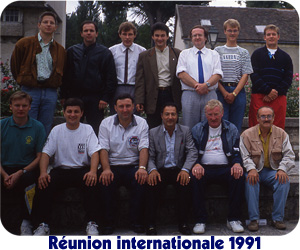The following article was written by Laurent Garnier of the French Federation around 1994, after the World Cup in Paris. The first part (origins of table football) was written back in the days when the internet was still just a thought in Al Gore's brain so it is quite possible there are some mistakes in there. The original article in French is available at French Table Foot Fed. It is titled "La Grande Histoire du Football de Table".
The Great Story of Table Football
It can be split into 5 large parts that we have titled:
- The origins of Table Football
- First competitions
- From ETF to FISA
- A new international orientation
- From Subbuteo to Table Football
The origins of Table Football
"History says ... that the first appearance of 'miniaturized' football happened in the twenties, a little bit before the great depression in England."
Football, invented by the English, exists since the end of the XVIIIth century and has always created many passions. The first experiment in "miniaturized" football took place on ships. Indeed, sailors not able to play football because of lack of space, had built small rudimentary figurines and a ping-pong sized ball out of lead. It is therefore not by chance that William Lane Keelings had the idea of inventing a miniature football game.
Several games, like "BLOW FOOTBALL" and "SHOOT" were already inspired by football but were lacking realism. W. L. Keelings tried to reproduce a game that drew closest to real football. He thus built the first table football game.
He cut bases in rubber washers and the figurines in stiff cardboard. After several tries, he found a satisfying scale and assembling [for the figurine-base combination, translater's note]; the goals were made with steel wire and the ball was made of cork. All that remained for him to do was to trace the playing field with some chalk on a blanket and outline rules (in particular, propulsion by flicking). This done, he found a solution for the goal-keeper: a rod allowing its manipulation from behind the goal.
From Newfooty to Subbuteo
 In view of the immediate success of his game, he realized the potential market of his invention. On may 25th 1929, he receives the inventor's patent for "Newfooty". With the financial help from his bank, W. L. Keelings starts producing his game. The demand is such that it becomes necessary to spread the fabrication of the various parts to several companies: the bases are made in London by ACME seals, the figurines in Bristol by Robinsons and finally the boxes and balls are imported from Germany. For his part, W. L. Keelings takes care of the goals, that he now makes out of thin stainless steel: the "deluxe" goals. Nevertheless, he keeps building basic goals for the cheaper sets. The pitches are first made by his sons who trace the playing field with chalk and the central circle using a 78 rpm record! W. L. Keelings takes care of the packaging and shipping because up until the 50s, the game was only sold through mail-order.
In view of the immediate success of his game, he realized the potential market of his invention. On may 25th 1929, he receives the inventor's patent for "Newfooty". With the financial help from his bank, W. L. Keelings starts producing his game. The demand is such that it becomes necessary to spread the fabrication of the various parts to several companies: the bases are made in London by ACME seals, the figurines in Bristol by Robinsons and finally the boxes and balls are imported from Germany. For his part, W. L. Keelings takes care of the goals, that he now makes out of thin stainless steel: the "deluxe" goals. Nevertheless, he keeps building basic goals for the cheaper sets. The pitches are first made by his sons who trace the playing field with chalk and the central circle using a 78 rpm record! W. L. Keelings takes care of the packaging and shipping because up until the 50s, the game was only sold through mail-order.
The ever growing demand forces him to move out to a bigger house. Thus, in 1933, the whole family finds itself relocated at 38 Barlow's Lane in Liverpool's Fazakerly neighborhood. A nice house and a big garage allow to momentarily resolve the infrastructure problems caused by the game's explosion, the advertising of which is confidential but very effective. This situation lasts until the second World War in 1939; production will resume in 1947.
After the war, materials are hard to come by, the costs of the first games coming from pre-war stock have increased considerably. The production restart requires changes in providers in order to maintain reasonable prices. Austins of Speke make the figurines and the boxes, the balls are made in France in two different sizes, the pitches are produced in Southport then Liverpool and Manchester by Masco (it is then that the shooting zone as we know it today is created).
In 1948, the figurine bases undergo a modification. Originally black or colored in blue or red, a colored disc is added to the top part. This modification provokes a slight unbalance, corrected with the addition of a metallic washer in 1952.
In 1949, plastic makes its appearance; the goals and the figurines are made by U.K. Plastics in London.
A new era begins
 The period 45-47 brings about a new figure who will turn the small world of table football upside down. Peter Adolph, ornithologist, is also a football fan. He finds the figurines of W. L. Keelings not very realistic and decides to make three-dimensional figurines [actually, the 3d figurines will come later in the early 60s. Adolph started with "flat" cardboard figurines. Translater's note]. The result is remarkable, he thinks about calling his invention "Hobby", desirous to combine his passion for birds with his enthusiasm for his new game. The "Hobby" is a falcon species, Falco Subbuteo, which by the way has remained for a long time the symbol of the Subbuteo Association. As the rights to use this name is not granted, he has the idea to choose "Subbuteo" (part of the bird's latin name, Falco Subbuteo) for the name of his new game. He files a patent and creates the Subbuteo Sports Games company. From then on, competition would take place, since beside the figurines, the equipment was virtually indentical to Newfooty.
The period 45-47 brings about a new figure who will turn the small world of table football upside down. Peter Adolph, ornithologist, is also a football fan. He finds the figurines of W. L. Keelings not very realistic and decides to make three-dimensional figurines [actually, the 3d figurines will come later in the early 60s. Adolph started with "flat" cardboard figurines. Translater's note]. The result is remarkable, he thinks about calling his invention "Hobby", desirous to combine his passion for birds with his enthusiasm for his new game. The "Hobby" is a falcon species, Falco Subbuteo, which by the way has remained for a long time the symbol of the Subbuteo Association. As the rights to use this name is not granted, he has the idea to choose "Subbuteo" (part of the bird's latin name, Falco Subbuteo) for the name of his new game. He files a patent and creates the Subbuteo Sports Games company. From then on, competition would take place, since beside the figurines, the equipment was virtually indentical to Newfooty.
For his part, W. L. Keelings, who works in a Liverpool photographic laboratory, is able to take care of the Newfooty production, thanks to an agreement with his bosses. Hard work soon enables him to work full-time on his enterprise.
Little by little, retailers and toy stores are interested in the game and act as resellers; the sale by mail-order not being anymore the only means of distribution, demand becomes greater. Several football clubs equip themselves with Newfooty and Subbuteo in order to prepare their tactics on the green pitch! (the black board being set aside for the circumstance).
The demonstrations begin to multiply and several football players like Sir Stanley Matthews and Nat Lofthouse lend themselves with good grace to this type of promotional events.
In 1956, the Newfooty company buys its latest factory in a Kirkdale industrial zone. It is bought back some time later by Subbuteo, W. L. Keelings having decided to retire.
First competitions
The competition between the two "inventors" does not create any problem as they develop the game independently of each other. The game has made many adepts and under the increasing number of players, clubs are forming and tournaments are organized. It is thus under the impulse of club managers that the Table Soccer Players Association (T.S.P.A.) is created in 1963. This has an impact in all countries where table football is played and as early as 1963, in spite of financial difficulties, the first European Cup takes place under the leadership of the Europa´chen Tischfussball F÷deration (E.T.F.), sort of European Federation (of Swiss origin).
In 1965, in London, a meeting is held where it is decided that the Subbuteo company will financially support the new Britsh Subbuteo Table Soccer Association (B.S.T.S.A.) and Peter Adolph is elected President. This association counts around 30 clubs for 400 members.
The split
In 1967, Peter Adolph calls for an extraordinary general meeting in London to resolve the main problems caused by the size of the United Kingdom. The Welsh and Scottish create their own associations and the B.S.T.S.A. is broken up into three parts: WELSH TSA, SCOTTISH TSA and ENGLISH TSA (E.T.S.A.), the three associations keeping the financial backup from the Subbuteo Sports Games company.
Around 1970, the company is bought by the biggest toy manufacturer in the U.K.: Waddingtons. This change does not happen without some problems and quite rapidly, diverging views are starting to surface. On one side the toy maker, on the other the player, each trying to impose its/his views. Many psychological mistakes are committed right from the start. Waddingtons, faced with productivity and profitability problems, modernizes itself, develop machining tools, increase its production, its strength. All these factors explain in part the direction it wishes to give to Subbuteo.
The players are passionate people and react as such. They do not have the vision to take this opportunity that is offered to them. Follows a hang-up that will get worse, as months go by. Several contentious issues oppose the players and Waddingtons.
 In 1970, the figurines made by Subbuteo are exclusively three-dimensional (like the ones today). The maker proposes then to the E.T.S.A. financial support under the condition that the E.T.S.A. "bans" the use of the old figurines in cardboard or flat plastic [the so-called "flats", translater's note]. This condition is judged unacceptable by the E.T.S.A. in the name of liberalism in sports. The split is consumed between the two parties. As each stays on its ground, the situation does not evolve. The E.T.S.A. keeps organizing competitions and structuring itself as best as it can.
In 1970, the figurines made by Subbuteo are exclusively three-dimensional (like the ones today). The maker proposes then to the E.T.S.A. financial support under the condition that the E.T.S.A. "bans" the use of the old figurines in cardboard or flat plastic [the so-called "flats", translater's note]. This condition is judged unacceptable by the E.T.S.A. in the name of liberalism in sports. The split is consumed between the two parties. As each stays on its ground, the situation does not evolve. The E.T.S.A. keeps organizing competitions and structuring itself as best as it can.
Waddingtons takes advantage of its strength to win over numerous youngsters who, far from all this ethical problems, are seduced by the game. The operation succeeds since in 1970 the first Subbuteo World Cup takes place in London following an Italian initiative; F.R.G. [Federal Republic of Germany, translater's note] wins over Belgium by 2 goals to 0. Waddingtons opts for one World Cup every four years just like in football. Each event is preceded by a big advertising campaign and the payback at the consumer lever is immediate. Subbuteo is known the world over, the toy is well liked and it sells well; Waddingtons simply looks for ways to widen the distribution. Far from the company are the problems relating to cardboard or plastic for the figurines!
From E.T.F. to F.I.S.A.
 E.T.F. carries on with numerous purists and organizes every year its European Cup in a different country. It counts up to 11 affiliated nations, which, considering its limited resources, is quite a feat.
E.T.F. carries on with numerous purists and organizes every year its European Cup in a different country. It counts up to 11 affiliated nations, which, considering its limited resources, is quite a feat.
The technical level reached by some players is remarkable. Alone till now for organizing events, E.T.F. must face a serious competitor. Several countries discouraged by the lack of good results firmly turn to the maker. 1976 is a turning point year for E.T.F. which loses numerous nations in the process.
From then on, two types of competitions are organized: the Subbuteo competitions where only Subbuteo gear is used and the E.T.F. competitions where any table football equipment is authorized (cardboard figurines, steel goals, etc).
To cut short any discussion regarding the sporting value of the competitions organized by Subbuteo and also to coordinate and supervise the world network of Subbuteo associations, Waddingtons creates in 1979 the F.I.S.A. (International Federation of Subbuteo Associations).All the national associations are invited to take part.
 Composed of a Board of Directors and presided by Bobby Charlton, former Manchester United and England player, this new federation is immediately the subject of criticism because in fact, it is managed entirely by the Subbuteo distributors and the players have no decision power. The international rules are decided in an arbitrary fashion and not submitted to any rigorous testing. The first large event ever organized by the Federation is the World Cup in Spain in 1982. This World Cup is the most important ever with the participation of 23 nations and taking place over three days.
Composed of a Board of Directors and presided by Bobby Charlton, former Manchester United and England player, this new federation is immediately the subject of criticism because in fact, it is managed entirely by the Subbuteo distributors and the players have no decision power. The international rules are decided in an arbitrary fashion and not submitted to any rigorous testing. The first large event ever organized by the Federation is the World Cup in Spain in 1982. This World Cup is the most important ever with the participation of 23 nations and taking place over three days.
Remarkable demonstration which on a general note is to be ranked among the top competitions even though the purely sporting aspect suffered somewhat from rules that were lacking logic and good sense. It is not easy to set yourself up as a sports organizer when you only have commercial experience.
Subsequently, F.I.S.A. organizes an international rules seminar in Paris which, if the intention is good, does not lead to anything concrete. It supports an international meet in Spa (Belgium) in 1983, organizes in 1984 the European Championship in Paris at the "Parc des Princes" and in 1986 the World Cup in Athens.
A new international orientation
From then on, a new push toward an international development appears, in particular under the French impulse in 1987.
 Indeed, an autonomous organization that is more and more rigorous and inspired from the large sports federations brings a new spirit and creates new player categories (women, U-12, etc). The situation is unique in a world where the Subbuteo distributors always have all the cards. The high point of this French influence on the Subbuteo world is without a doubt the most important event ever organized so far: a 4-person team world competition at Bercy (Paris), international sports center.
Indeed, an autonomous organization that is more and more rigorous and inspired from the large sports federations brings a new spirit and creates new player categories (women, U-12, etc). The situation is unique in a world where the Subbuteo distributors always have all the cards. The high point of this French influence on the Subbuteo world is without a doubt the most important event ever organized so far: a 4-person team world competition at Bercy (Paris), international sports center.
On September 20th 1987, twelve countries answer the call and send their delegations with 2 seniors, one junior and ... one woman. The staging and advertising surrounding the event bring visions of a different future definitely geared toward a more mature audience.
This latest competition is also the first organized from A to Z by Federation managers. F.I.S.A will take over with the European Championships in Bruxelles in 1988.
In the mean time, each country organizes itself. The French clubs develop the International Grand Prix. These events experience a fantastic international expansion in very little time. The best European players meet on a regular basis. Attendance records are broken (almost) every time (144 players, 10 countries represented).
1989 is the year of dialogue. A F.I.S.A. meeting is held in Paris with the seven main nations about an harmonization of the game rules. Other players (often the best) and other countries (like France) do not hesitate anymore to take part in F.I.S.A. and E.T.F. competitions.
 In April 1990, Laurent Garnier, the fiercest supporter of an international sports entity which would be run independently of the commercial system, is elected by all the nations, meets the English managers from Waddingtons to negociate. Mentalities evolve and the end of the tunnel is near. All the more since in Rome, during the F.I.S.A. World Cup (with Singapore, the U.S.A., Australia, etc), the people present clearly demonstrate the desire for a unique sports solidarity.
In April 1990, Laurent Garnier, the fiercest supporter of an international sports entity which would be run independently of the commercial system, is elected by all the nations, meets the English managers from Waddingtons to negociate. Mentalities evolve and the end of the tunnel is near. All the more since in Rome, during the F.I.S.A. World Cup (with Singapore, the U.S.A., Australia, etc), the people present clearly demonstrate the desire for a unique sports solidarity.
Thus, the F.I.S.A.-E.T.F. dispute, two decades old, loses its momentum for everybody's delight. Disagreements still exist. But for how much longer?
Hamburg: May 1992. During the European Championships in the German city, the participating federations decide the creation of the F.I.S.T.F. (International Federation of Subbuteo Table Football).
A Board [of Directors, translater's note] is appointed for two years (92-94). It is composed of 5 members elected by the federations. Laurent Garnier is named President, assisted by Allan COOK (G.B.) replaced in 1993 by Alessandro ROSSI (Italy), Willy HOFMANN (Switzerland), Trevor SPENCER (G.B.) and Frits VENDEBAEK (Denmark).
The role of this Board will be to put in place committees to go over the game rules, the international calendar and the management of the main international competitions (World Championships, European Championships and International Grand Prix).
From Subbuteo to Table Football
The first order of business for the brand new International Federation will be to bring together all the nations under the same banner. The doubts and power struggles are numerous between those that think the F.I.S.T.F. is an artificial federation led behind the scenes by Waddingtons (the presence of the English Trevor Spencer who is employed by the company and elected to the Board does not reassure anybody) and those "pro" Waddingtons who see in this independent federation the end of their benefits acquired during the Subbuteo years. The task is not simple for the French president who must convince the doubters.
A formidable trial of strength then takes place: the Board backs its president to alleviate the pressure from Waddingtons.
A great number of sports related decisions are taken in order to show everybody the autonomy of the brand new federation. One of the most important, which will enable to win over numerous nations, will be to allow everybody to play with the type of figurine they wish. The battle between "flat" and three-dimensional figurines is over.
Follows a better definition of allowable equipment and possibilities are offered to countries to make or produce equipment according to the international standards. Willy Hoffmann, former World Champion and excellent technician, handles the development of the sport and its equipment.
The institution of international competitions like the individual European Cup every two years in alternance with the World Cup, the creation of a player world ranking and the setting up of various categories rapidly seduce the member nations.
Of course, it is only in theory and the reality is a whole other matter. The lack of support forces F.I.S.T.F. to make some concessions to Waddingtons in order to find a partnership.
Verviers 93 in Belgium will be the first European Cup organized under the banner of F.I.S.T.F.; the support coming from Waddingtons will be timid with equipment donation. The most remarkable fact is without contest the unveiling of new figurines made by the Swiss company Global Sports Games, called "Sports Figurines", promoted by their creator Willy Hofmann; prototypes that are about to revolutionize the small world of table football.
Reactions are immediate. If the players unanimously do not really like the aesthetics (the figurines are made of flat polystyrene for the body and plastic for the base), their technical quality is undeniable.
For the International Federation, this initiative represents one step towards the technical development of the equipment and it shows its willingness to detach itself from the Waddingtons monopoly. The objective is clear: make competition between makers work towards having the best possible equipment for the players and develop a sports approach to table football.
1994 will confirm the Board in its conviction. The competition system goes into place progressively, the International Grand Prix become more important, the world ranking takes shape, the World Cup announces itself under the best auspices.
Waddingtons takes advantage of this moment to launch a promotional campaign named for commercial reasons "World Cup Subbuteo 94" in the U.S.A., which provokes confusion within F.I.S.T.F. After numerous discussions, it is agreed that a friendly tournament would be organized with the help of F.I.S.T.F. in Chicago. This competition would not grant the title of World Champion. Won by the Belgian Raymond Demarco over the Frenchman Christophe Fuseau, the competition which took place under a tent has nothing to do with a table football tournament, it is more like a demonstration in a department store.
Moreover, F.I.S.T.F. with the support of the organizational committee for the World Cup created under the leadership of the French Federation bustles about to organize the World Cup. The challenge is sizeable and the organizers know that they have to succeed if they want to definitively convince the doubters.
The success is total, the organizers spent a lot of energy and the results are here. A superb individual competition to which is added a team competition between the nations. History will remember the incredible run of the Belgium delegation which wins the individual titles in the open and women categories and conquers the first world team tournament.
Considered the biggest event in recent years, the table football World Cup which took place in Paris in September 94 will remain in people's memories for a long time.
The logical conclusion of this result is the unanimous re-election of the French president Laurent Garnier at the head of F.I.S.T.F. The Board is however modified following the resignation of Alessandro Rossi and the power struggles which persist between the two main factions. Thus, the big loser is the English Trevor Spencer who will not be re-elected, to the benefit of the Italian Stefano Buzzi joined by the Australian Steve Dettre. Willy Hofmann and Frits Vendebaek will keep their seats but tensions remain within the Board.